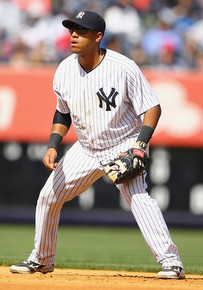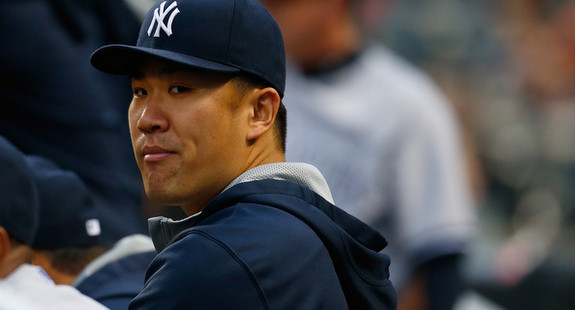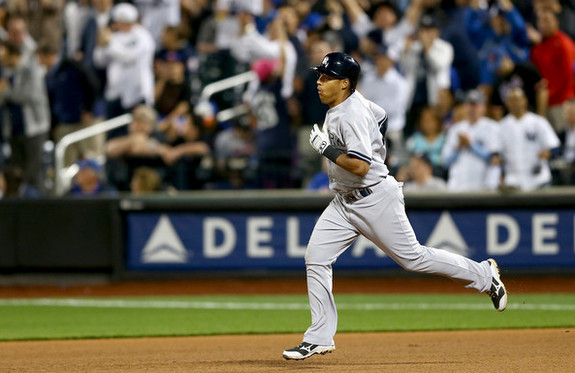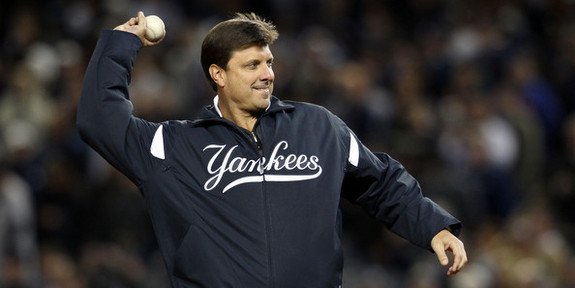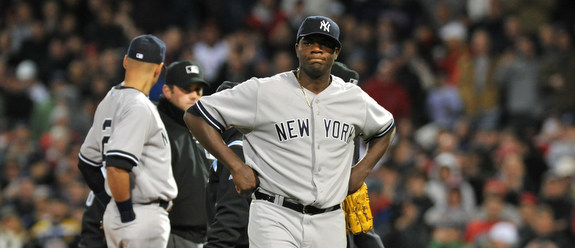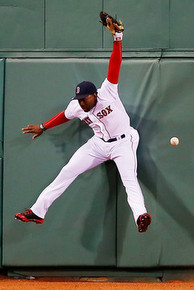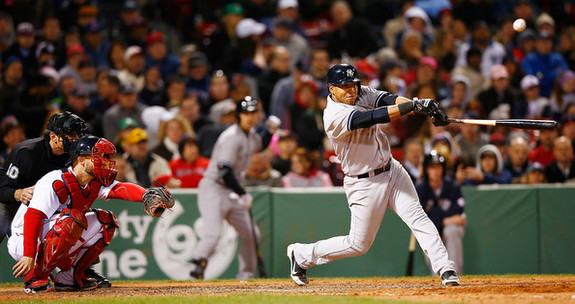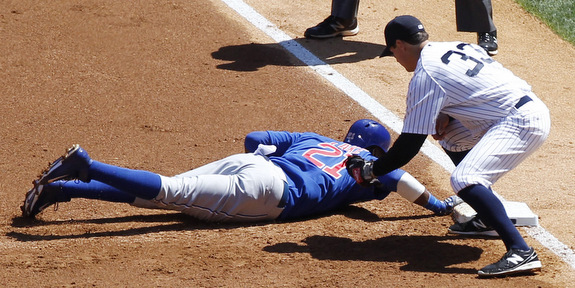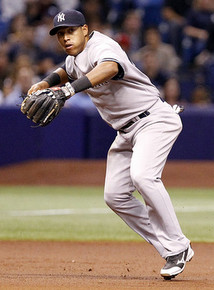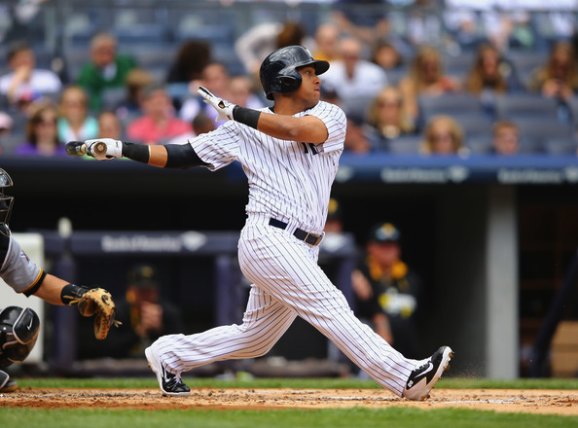
We all want to believe his emergence is real. He’s had 200 plate appearances. He has slumped and made us think that the spell was broken. Just when we think it’s over, he comes back and starts hitting again.
Where would the Yankees be without Yangervis Solarte?
Actually, don’t answer that. We read your comments and your tweets. The answer would only depress us.
Much joy as his early season performance has brought, Solarte has a long way to go before he proves he’s for real. History just isn’t on his side. Players typically don’t debut at age 26 and hit like borderline stars.
Hell, players don’t debut at age 26 and even qualify for the batting title. Only 44 have done it since 1901, and three quarters of them did it before 1950. Of those, only seven of them did so in what is termed the Expansion Era (1973 to present).
Even of those seven, two were Cuban defectors: Yoenis Cespedes and Alexei Ramirez. No, they didn’t have MLB experience before their age-26 seasons, but they also weren’t prospects who toiled in mediocrity before suddenly breaking out.
That leaves us with just four decent comparisons to Solarte (Rookie of the Year voting finish in parentheses).
| Rk | Player | Year | Tm | G | PA | H | 2B | 3B | HR | RBI | BB | SO | SB | ||||
|---|---|---|---|---|---|---|---|---|---|---|---|---|---|---|---|---|---|
| 1 | Yoenis Cespedes (2nd) | 139 | 2012 | OAK | 129 | 540 | 142 | 25 | 5 | 23 | 82 | 43 | 102 | 16 | .292 | .356 | .505 |
| 2 | Yangervis Solarte | 129 | 2014 | NYY | 53 | 214 | 56 | 12 | 0 | 6 | 26 | 21 | 23 | 0 | .298 | .366 | .457 |
| 3 | Dan Uggla (3rd) | 112 | 2006 | FLA | 154 | 683 | 172 | 26 | 7 | 27 | 90 | 48 | 123 | 6 | .282 | .339 | .480 |
| 4 | Chris Singleton (6th) | 105 | 1999 | CHW | 133 | 530 | 149 | 31 | 6 | 17 | 72 | 22 | 45 | 20 | .300 | .328 | .490 |
| 5 | Chris Sabo (1st) | 105 | 1988 | CIN | 137 | 582 | 146 | 40 | 2 | 11 | 44 | 29 | 52 | 46 | .271 | .314 | .414 |
| 6 | Alexei Ramirez (2nd) | 104 | 2008 | CHW | 136 | 509 | 139 | 22 | 2 | 21 | 77 | 18 | 61 | 13 | .290 | .317 | .475 |
| 7 | David Eckstein (4th) | 89 | 2001 | ANA | 153 | 664 | 166 | 26 | 2 | 4 | 41 | 43 | 60 | 29 | .285 | .355 | .357 |
Dan Uggla
When I thought of players who debuted at 26 and thrived, Uggla immediately came to mind. It wasn’t long ago at all that the Marlins selected him in the Rule 5 draft, inserted him into the starting lineup, and watched him smash 27 home runs.
Uggla didn’t have a terrible minor league career; it just took him three-plus years to get out of A ball. He actually thrived at AA in 2005, but apparently it wasn’t enough for the Diamondbacks to place him on the 40-man roster.
Solarte could do worse than to emulate Uggla’s career. Sure, he’s toast right now, at age 34, but he had a pretty good run for about six years, hitting .258/.343/.482 (116 OPS+).
David Eckstein
Yes, everyone’s favorite scrappy underdog didn’t debut until age 26. He’d actually hit pretty well throughout his minor league career, but struggled a bit upon hitting AA in 2000. The Red Sox placed him on waivers and the Angels claimed him.
In 2001 he debuted and hit not so great, .285/.355/.357. That might be remarkable in today’s game, but back then it was an 89 OPS+. He did go on to have a few decent seasons after that, including a 101 OPS+ in the Angels’ 2002 championship season.
Chris Singleton
A second round pick in 1993, Singleton struggled early in his minor league career. He didn’t flash even half-decent power until age 23, and didn’t have a good season until age 24. After that good season, the Giants traded him to the Yankees for Charlie Hayes. But he proceeded to have a bad season, so the Yankees traded him to the White Sox for some guy you’ve never heard of.
Singleton broke camp with the Sox in 1999 at age 26 and proceeded to hit .300/.328/.490 and finish sixth in the AL Rookie of the Year Award voting. Singleton would never produce even average numbers again (his slash line was good for a 105 OPS+ in 99).
Chris Sabo
Yes, the goggled dude took a while to incubate in the minors. In fact, he spent two full seasons at AAA before making his debut. He certainly hit well enough to earn it. In his first season he hit .271/.314/414, a 105 OPS+ that earned him the NL Rookie of the Year Award. Two years later he won a World Series.
Sabo had a few good seasons, including a pretty monster 1991 season, but he peaked in his late 20s. As did most of these guys. As do most players, really.
The craziest part about this list: Solarte right now has better numbers than all of them. You’d have to count the Cuban players to find one who put up full-season numbers better than Solarte is currently producing. (Cespedes, obviously.)
At the same time, he probably has the least impressive minor league track record among the five drafted players who debuted at age 26. He certainly spent the longest time down there. Sabo, Eckstein, Singleton, and Uggla all got drafted out of college. Solarte was signed as an amateur free agent at age 17 and debuted stateside at age 19.
Given the thin history of players who debuted at 26, it is still difficult to believe that Solarte can keep up his hot hitting. Not only are there few players who debuted at 26 and qualified for the batting title, but none of them, save for Cuban defectors, hit nearly as well as Solarte.
Still, I want to believe. There has to be some magic about this team. Right?
